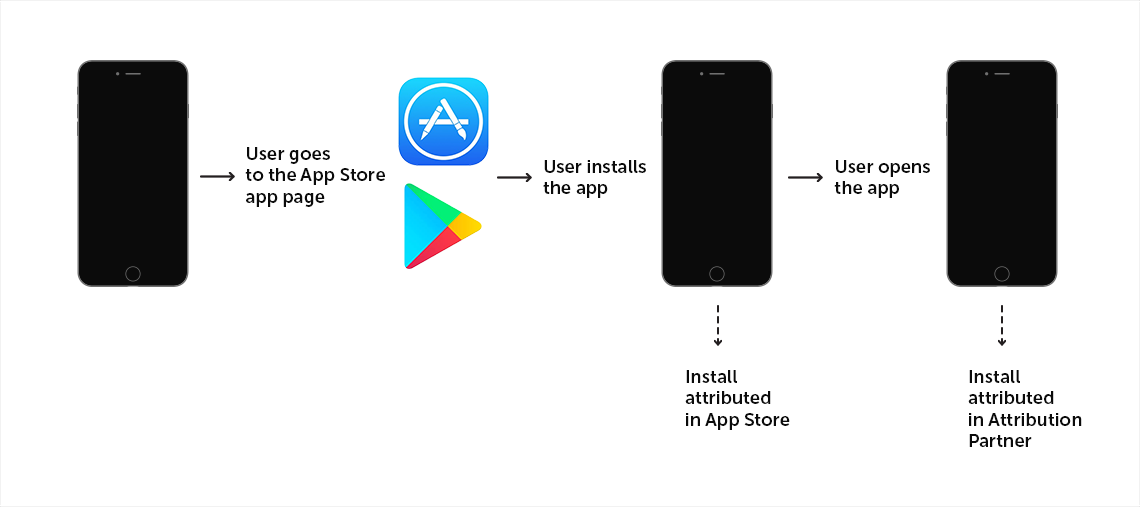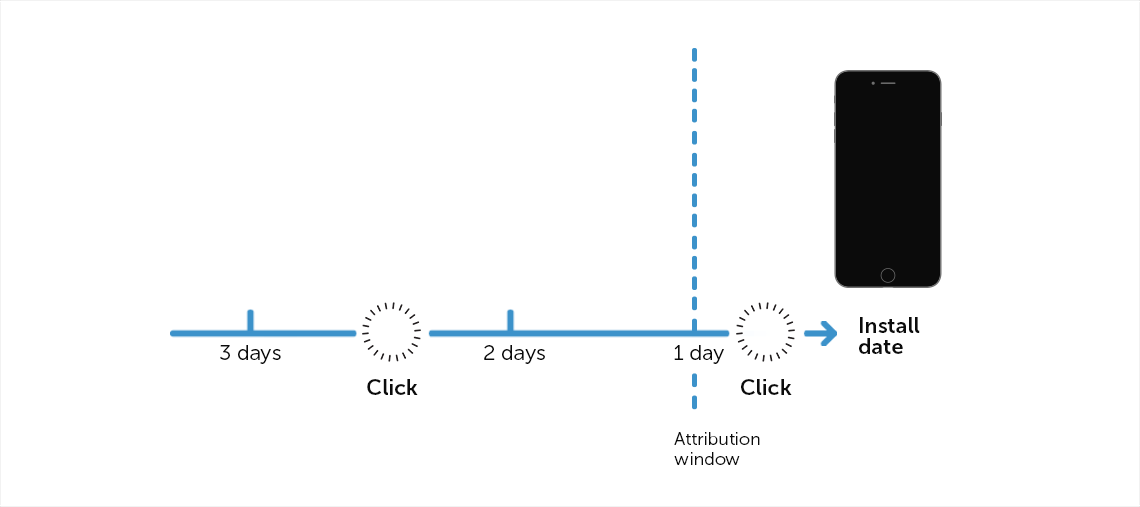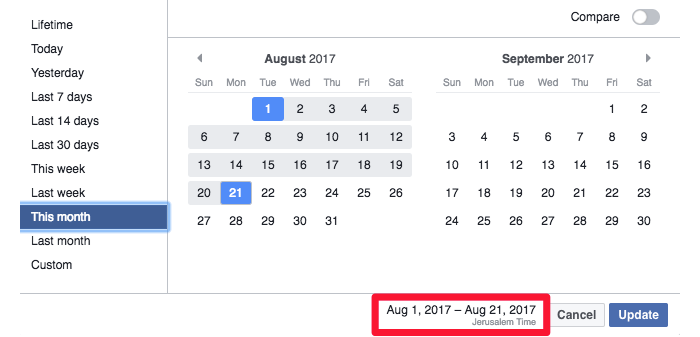Mobile marketing: discrepancies in installation statistics
Show me two dashboards with the same data, and I will say that one of them is lying or at least blindly copying the numbers. Anyway, in the work of the modern marketer differences are inevitable.
Can I get rid of them? Unfortunately not. Is it worth it to understand the reason? Yes, because it will allow you to:
In this article we will look at the main metrics of attracting users - installation.
')

What is installation in terms of mobile attribution platforms (Adjust, Tune, Appsflyer, Kochava, etc.)? Logically, the installation takes place immediately after downloading the application from the App Store, right? And no.
Most analytics systems count the installation when the user first launches the application (some systems even call it download). The reason is that most analytics systems only receive data from the SDK installed in the application. Therefore, the earliest stage when they can define a new installation is only after the application has started.
There are only two systems that can count actual installations, the Google Play Console and iTunes Connect. Comparing their statistics with the data of attribution platforms, you will surely see discrepancies.

Below are several scenarios that could lead to discrepancies in data for this reason.
Of course, the last two cases can be avoided if you properly debug the work of the SDK.
Another interesting fact: the Google Play Console and Itunes Connect consider the installation based on the ID of accounts, and the attribution platform based on the device ID (GAID / IDFA).
For example:
In such cases, to avoid inconsistencies will not succeed. You can only determine their acceptable level, which, as a rule, will depend on your application.
Let's start with the definition. The attribution window is the time interval from the first contact with the advertisement of the application to its installation. The problem is that attribution windows are not always the same.
Suppose a user clicked on an advertisement on August 1, and installed the application on August 3.

For the installation to be counted, the time between the click and the installation should not exceed the attribution window.
It is worth noting that the attribution window for clicks and impressions can be configured separately. A good example is Facebook. Here we can customize the attribution windows and watch the data change on the fly.
Facebook allows you to select one of three attribution windows for views and clicks: 1, 7 or 28 days. If you do not configure windows manually, data will be tracked by default (1 day for views and 28 days for clicks). Such flexibility is rarely seen when working with attribution platforms.

Here you can set up attribution windows in Facebook.
Remember that before comparing data on installations, check that the attribution windows of the advertising network and the attribution platform are the same.
The following type of discrepancies is often found in the largest advertising networks: Google Adwords, Facebook, Yahoo, Twitter.
Ad networks claim to be installed without knowing the user's interactions with other networks. In other words, different networks may assign the same installation to themselves.
But here attribution platforms come into play. They collect data on all the clicks in the attribution window and count only the last one.
As an example, consider Google and Facebook.

For example, before installing an application, a user clicked on an advertisement on Facebook, and then on Google. Naturally, Google Adwords will assign the installation to itself, and Facebook to itself. But, according to the rule of the last click, the attribution platform counts the installation of Adwords.
We talked about the giants of the industry, but what about everyone else. How does everyone else work? After the attribution platform counted the installation on the last click, it sends the data to the advertising partner through the postback. Without a proper setting of the postback sending mechanism, statistics on settings in the ad network may not be displayed at all. Sometimes in the data sent via postback, there are no required parameters (for example, clickID). In such cases, the installation will not be registered.
To solve the problem it is best to contact the account managers of both parties. But this may take some time, so if a partner can give you access to the logs, this will be a big plus.
Some analytics systems show settings for views and clicks separately, while others show together. Therefore, before comparing the data, specify how the settings are displayed in the analytics.
Everything is very simple here. Comparing the number of installations on two different platforms, you need to consider in which time zone they work. Most modern systems display data for different time zones, so there are hardly any problems.

Facebook shows the time zone of your account.
Sometimes it seems to us that we look at the data from one angle, but in fact it is not. Different partners use different approaches to displaying data.
Consider this on the example of Google AdWords.
AdWords displays all conversions, including installations, based on the date of the click, not the installation. And most attribution platforms are just the opposite. If a user clicks on an ad on August 3 and installs an application on the 4th, the 3rd number will be displayed in AdWords analytics, and the 4th in the partner analytics.
So, we have considered most of the reasons for discrepancies in the number of installations in the mobile market. If you encounter similar problems, join the discussion in the comments.
Can I get rid of them? Unfortunately not. Is it worth it to understand the reason? Yes, because it will allow you to:
- better understand user behavior;
- find the most appropriate data sources for specific reports;
- more effectively respond to data corruption;
- notice technical errors in the application, without looking at the code;
- determine the acceptable level of discrepancies.
In this article we will look at the main metrics of attracting users - installation.
')

App Store and Platform Attribution Analytics: When Installation Doesn’t Count
What is installation in terms of mobile attribution platforms (Adjust, Tune, Appsflyer, Kochava, etc.)? Logically, the installation takes place immediately after downloading the application from the App Store, right? And no.
Most analytics systems count the installation when the user first launches the application (some systems even call it download). The reason is that most analytics systems only receive data from the SDK installed in the application. Therefore, the earliest stage when they can define a new installation is only after the application has started.
There are only two systems that can count actual installations, the Google Play Console and iTunes Connect. Comparing their statistics with the data of attribution platforms, you will surely see discrepancies.

Below are several scenarios that could lead to discrepancies in data for this reason.
- The user installed the application, but never launched it.
- The user launched the application a few days after installation.
- The user installed the application, uninstalled it, and then reinstalled it.
- The user has installed the application, but before the SDK was launched, it crashed.
- The SDK did not start immediately, but later - for example, after downloading additional content.
Of course, the last two cases can be avoided if you properly debug the work of the SDK.
Accounts or devices?
Another interesting fact: the Google Play Console and Itunes Connect consider the installation based on the ID of accounts, and the attribution platform based on the device ID (GAID / IDFA).
For example:
- The user installs the application on two Android devices with the same account ID. Google Play will consider it for one installation, and the attribution platform - for two.
In such cases, to avoid inconsistencies will not succeed. You can only determine their acceptable level, which, as a rule, will depend on your application.
Partners and ad networks: have you set up an attribution window?
Let's start with the definition. The attribution window is the time interval from the first contact with the advertisement of the application to its installation. The problem is that attribution windows are not always the same.
Suppose a user clicked on an advertisement on August 1, and installed the application on August 3.
- If the attribution window is configured for 3 days or more, the installation is set off.
- If the attribution window is set to 1 day, the installation will not be counted.

For the installation to be counted, the time between the click and the installation should not exceed the attribution window.
It is worth noting that the attribution window for clicks and impressions can be configured separately. A good example is Facebook. Here we can customize the attribution windows and watch the data change on the fly.
Facebook allows you to select one of three attribution windows for views and clicks: 1, 7 or 28 days. If you do not configure windows manually, data will be tracked by default (1 day for views and 28 days for clicks). Such flexibility is rarely seen when working with attribution platforms.

Here you can set up attribution windows in Facebook.
Remember that before comparing data on installations, check that the attribution windows of the advertising network and the attribution platform are the same.
My click or last click?
The following type of discrepancies is often found in the largest advertising networks: Google Adwords, Facebook, Yahoo, Twitter.
Ad networks claim to be installed without knowing the user's interactions with other networks. In other words, different networks may assign the same installation to themselves.
But here attribution platforms come into play. They collect data on all the clicks in the attribution window and count only the last one.
As an example, consider Google and Facebook.

For example, before installing an application, a user clicked on an advertisement on Facebook, and then on Google. Naturally, Google Adwords will assign the installation to itself, and Facebook to itself. But, according to the rule of the last click, the attribution platform counts the installation of Adwords.
Did you get my postback?
We talked about the giants of the industry, but what about everyone else. How does everyone else work? After the attribution platform counted the installation on the last click, it sends the data to the advertising partner through the postback. Without a proper setting of the postback sending mechanism, statistics on settings in the ad network may not be displayed at all. Sometimes in the data sent via postback, there are no required parameters (for example, clickID). In such cases, the installation will not be registered.
To solve the problem it is best to contact the account managers of both parties. But this may take some time, so if a partner can give you access to the logs, this will be a big plus.
Click, view, or both?
Some analytics systems show settings for views and clicks separately, while others show together. Therefore, before comparing the data, specify how the settings are displayed in the analytics.
What time zone are you in?
Everything is very simple here. Comparing the number of installations on two different platforms, you need to consider in which time zone they work. Most modern systems display data for different time zones, so there are hardly any problems.

Facebook shows the time zone of your account.
Are we looking at the same thing? Types of reports
Sometimes it seems to us that we look at the data from one angle, but in fact it is not. Different partners use different approaches to displaying data.
Consider this on the example of Google AdWords.
AdWords displays all conversions, including installations, based on the date of the click, not the installation. And most attribution platforms are just the opposite. If a user clicks on an ad on August 3 and installs an application on the 4th, the 3rd number will be displayed in AdWords analytics, and the 4th in the partner analytics.
So, we have considered most of the reasons for discrepancies in the number of installations in the mobile market. If you encounter similar problems, join the discussion in the comments.
Source: https://habr.com/ru/post/341936/
All Articles